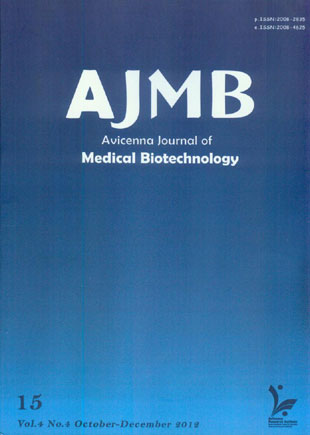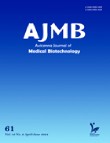فهرست مطالب

Avicenna Journal of Medical Biotechnology
Volume:4 Issue: 4, Oct-Dec 2012
- 60 صفحه،
- تاریخ انتشار: 1391/08/15
- تعداد عناوین: 9
-
-
Page 156
-
Page 160BackgroundPeroxisome Proliferator Activated Receptor gamma (PPARγ), a member of nuclear receptor superfamily, comprises two isoforms in mouse. These two isoforms are encoded by different mRNAs, which are arisen by alternative promoter usage. There are two promoter regions upstream of PPARγ gene. A 3 kb fragment, containing several transcription factor binding sites, acts as PPARγ1 promoter region. Thus, expression pattern of PPARγ1 isoform is due to the potential transcription factors that could influence its promoter activity. PPARγ, Retinoid X Receptor (RXR) and Vitamin D Receptor (VDR), as nuclear receptors could influence PPARγ gene expression pattern during several differentiation processes. During neural differentiation, PPARγ1 isoform expression reaches to maximal level at neural precursor cell formation.MethodsA vast computational analysis was carried out to reveal the PPARγ1 promoter region. The putative promoter region was then subcloned upstream of an EGFP reporter gene. Then the functionality of PPARγ1 promoter was assessed in different cell lines.ResultsResults indicated that Rosiglitazone increased PPARγ1 promoter regulated EGFP expression of neural precursor cells during Embryoid Body (EB) formation. Furthermore vitamin D reduced PPARγ1 promoter regulated EGFP expression of neural precursor cells during EB formation through binding to its receptor.ConclusionThis study suggests that there are potential response elements for PPAR/RXR and VDR/RXR heterodimers in PPARγ1 isoform promoter. Also VDR/RXR heterodimers may decrease PPARγ expression through binding to its promoter.Keywords: PPAR gamma, Mouse, Gene expression
-
Page 170BackgroundPan-IgG specific monoclonal antibodies (MAbs) are essential tools for assessment of humoral immunity, immune deficiency and gammopathy. In this study, four hybridoma clones producing MAbs with different specificities for human IgG isotypes were established.MethodsSplenocytes from Balb/c mice immunized with Fc fractions of human IgG were fused with SP2/0 myeloma cells. Hybridoma cells were selected in HAT selective medium and cloned by limiting dilution assay. Antibody-secreting cells were screened by enzyme-linked immunosorbent assay (ELISA) and the specificity of secreted MAbs was further analyzed using a panel of purified myeloma IgG proteins by ELISA and immunoblotting. Cross-reactivity to immunoglobulins (Igs) of other species was studied by indirect ELISA using serum samples collected from 9 animals.ResultsImmunoblotting studies revealed recognition of either linear or conformational epitopes by these MAbs. The most abundant cross-reactivity (100%) was observed with monkey Igs, while no cross-reactivity was detected with rabbit, guinea pig, sheep, goat, cat and hen sera. Two of the MAbs crossreacted with either dog or horse sera. The affinity constant of two MAbs was measured by ELISA and found to be 0. 74×108 M-1 and 0. 96×107 M-1.ConclusionOur results indicate that these pan-IgG specific MAbs recognize restrictedد linear or conformational epitopes located on all human IgG subclasses with no cross-reactivity to IgG from most species studied. These MAbs are potentially useful tools for quantification of total or antigen-specific IgG levels.Keywords: Enzyme linked immunosorbent assay, Hybridomas, Immunoglobulin isotypes, Monoclonal antibody
-
Page 178BackgroundBone Morphogenetic Proteins (BMPs) belong to the transforming growth factor-β (TGF-β) superfamily, and play an important role in bone metabolism. Recombinant forms of BMP-2 and BMP-7 are the only BMPs used clinically. In this study the mature part of human bone morphogenetic protein-7 (BMP-7) was engineered through substitution of the BMP-7 Nterminal sequence by heparin-binding site of BMP-2. This targeted substitution was made to enhance the binding affinity of the novel protein to the extracellular matrix components such as heparin and heparan sulfate proteoglycans (HSPGs).MethodsThe engineered protein was expressed in Escherichia coli (E.coli). The PelB signal sequence was used to translocate soluble proteins into the periplasmic space of E.coli. The protein was purified from periplasmic extract using Ni-NTA chromatography and the SDS-PAGE and western blot analysis confirmed the successful expression of the novel protein.ResultsThe novel hBMP-7 mutant was produced as approximately 16 kDa monomer. It was found that the heparin binding of this protein was approximately 50% more than that of the wild-type at a protein concentration of 500 ng/ml.ConclusionThe findings showed that the periplasmic expression may be suitable to produce complex proteins like BMPs.Keywords: Bone morphogenetic protein, 7 (BMP, 7), Escherichia coli, Periplasmic expression
-
Page 186BackgroundVarious prokaryotic and eukaryotic expression systems havebeen developed for the production of recombinant proteins. In the present study, we used a new protein expression system based on the Iranian Lizard Leishmania, a trypanosomatid protozoan as a host, for the expression of LPG3 gene from Leishmania infantum (L.infantum).MethodsThe LPG3 gene was cloned in the expression cassette for integration into the small subunit of the ribosomal RNA locus of Lizard Leishmania genome by electroporation. Expression of the recombinant LPG3 protein was confirmed by western blotting and immunofluorescence staining.ResultsWestern blotting confirmed the expression and production of rLPG3 protein. Immunofluoresence analysis also revealed the staining throughout the cytoplasm of transfected parasites, indicating that the protein has been expressed.ConclusionThese results demonstrate that Leishmania cells can be suggested an expression system for the production of recombinant LPG3 (rLPG3) to further research in vaccine designing against leishmaniasis.Keywords: Leishmania infantum, Leishmania, Recombinant proteins, Vaccines
-
Page 193BackgroundRetinoblastoma is the most common intraocular tumor in childhood and mutation in the RB1 gene will trigger the tumorigenesis. So far, a wide range of the mutations along the length of RB1 gene have been reported. However, some could not be detected by common detection methods. In such condition, linkage analysis using microsatellite markers is suggested to trace unknown RB1 mutations in the affected family. The aim of the present study was to evaluate the heterozygosity rates and genotyping of three microsatellite markers near or inside of the RB1 gene.MethodsTotally, 120 unrelated healthy people from Fardis, Karaj, Iran were recruited and from each participant genomic DNA was extracted from 5 ml of peripheral blood. Three microsatellite markers D13S153, D13S156 and D13S128 located within or adjacent to the RB1 gene were selected for linkage analysis. The reliability of microsatellite markers and linkage analysis were investigated in 10 members of 2 families with familial retinoblastoma.ResultsOur results showed that heterozygosity rates for the three markers D13S153, D13S156 and D13S128 were 74, 70 and 78%, respectively. On the other hand, 2 and 36 out of 120 people were homozygote and heterozygous for all loci, respectively.ConclusionGiven the heterozygosity rates, it may be concluded that all microsatellite markers D13S153, D13S156 and D13S128 are informative and have a high rate of heterozygosity and sensitivity. Therefore, tracing the unknown RB1 mutated alleles using linkage analysis in Iranian family with familial retinoblastoma could be recommended by means of these three microsatellite markers.Keywords: Genetic markers, Genotyping techniques, Iran, Retinoblastoma
-
Page 200A healthcare system has been the most important priority for all governments worldwide. Biotechnology products have affected the promotion of health care over the last thirty years. During the last several decades, Iran has achieved significant success in extending healthcare to the rural areas and in reducing the rates of infant mortality and increasing population growth. Biomedical technology as a converging technology is considered a helpful tool to fulfill the Iranian healthcare missions. The number of biotechnology products has reached 148 in 2012. The total sales have increased to 98 billion USD without considering vaccines and plasma derived proteins in 2012. Iran is one of the leading countries in the Middle East and North Africa in the area of Medical biotechnology. The number of biotechnology medicines launched in Iran is 13 products until 2012. More than 15 products are in pipelines now. Manufacturers are expecting to receive the market release for more than 8 products by the end of 2012. Considering this information, Iran will lead the biotechnology products especially in area of biosimilars in Asia after India in next three years. The present review will discuss leading policy, decision makers’ role, human resource developing system and industry development in medical biotechnology.Keywords: Biopharmaceutics, Human resources, Iran, Medical biotechnology
-
Page 206BackgroundRecently, we have shown that peroxisomal protein expression was induced upon retinoic acid treatment in mouse embryonic stem cells during the process of neurogenesis. Thus, characterization of the respective promoter could elucidate the molecular aspects of transcriptional regulation of this gene.MethodsUsing the conventional software programs for promoter prediction, a putative promoter region was identified approximately 561 bp upstream of the peroxisomal protein coding sequence. In order to clone this region with a GC-content of 71.01%, a cocktail of ammonium sulfate buffer supplied with two additive components, betaine and dimethyl sulfoxide, and a high concentration of MgCl2 was used.ResultsThe modulated polymerase chain reaction composition significantly improved the amplification of GC-rich DNA target sequences. Improved amplification of this region was due to reduction in the formation of secondary structures by the GC-rich region.ConclusionTherefore, this polymerase chain reaction composition could be generally used to facilitate the amplification of other GC-rich DNA sequences as verified by amplification of different GC rich regions.Keywords: Amplification, GC, rich region, Peroxsiomal protein, Promoter


